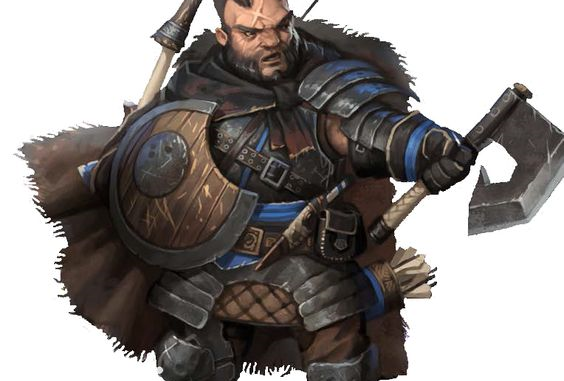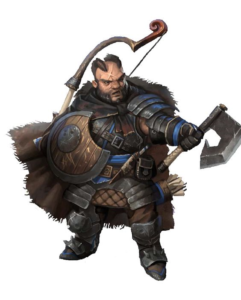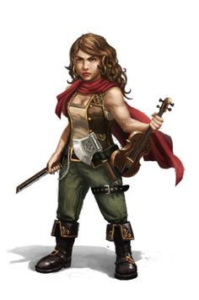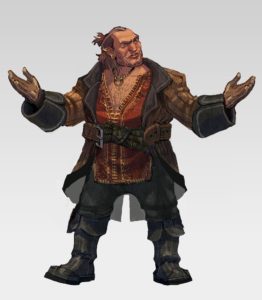
Today we’re going to take a look at a new subrace for the Dwarves as presented in the Dungeons and Dragons 5th Edition Player’s Handbook. While the Mountain and Hill Dwarves do a fine job of representing the “traditional fantasy dwarf” I’ve long been a fan of different and “counterculture” ways they can be used in games. Then one night this idea struck me and wouldn’t let go. We commonly see individual dwarves that have lost their clans in gaming fiction, but rarely does the concept of what happens when an entire clan gets displaced by war, political violence, or natural disaster. Faced with surviving topside, how different would these dwarves look from their more dour cousins underground? I’ll also admit to the idea of great groups of dwarven men without beards seated around tavern tables after a hard days’ work was endlessly amusing to me as well.
Not Your Typical Dwarf

While it is not uncommon for dwarves to find community and companionship above ground, most are at home deep beneath the earth in their clan halls and ancestral homes. Then there are dwarves like those that belong to Clan Smoothshield, the earliest recorded group of “surface dwarves” that make their homes above ground. Their communities are still predominantly (and oftentimes almost exclusively) dwarven, but they live often live near the cities of others races, freely trading and mingling with them as they need to.
Exiles and Outcasts
One of the more common ways entire clans find themselves forced into a life on the surface is when their homes and clanhalls are taken from them by forces of creatures also native to the underground. Despite their martial prowess, dwarves are not invincible in battle and sometimes orcs, goblins, or other creatures are able to overwhelm dwarven clans and force them from their homes, especially if the clans are already somewhat isolated from other kingdoms or concentrations of dwarven power. The dwarves that survive these kinds of attacks find themselves refugees that other clans may be hesitant (or unable) to bring into their own societies. Other times entire clans find themselves exiled after failed bids for power turn their leaders into social pariahs. Sometimes clanhalls and even entire kingdoms are lost to natural disasters that bury them under the very mountains that keep them safe from outside threat. Trading caravans or military units go missing or get hopelessly lost.

In times like these, faced with becoming clanless, disparate dwarves will choose to cast aside their previous identities and join together in a new society, founding new clanhalls on the surface. And while each of these new settlements more often than not finds an identity of their own, the common truth is that these new “surface” dwarves self-identify differently from their cousins that continue to live in their halls of stone. Over the centuries, as more and more of these settlements began to pop up, a sort of common “culture” did begin to spring up leading to some similarities between disparate settlements including clothing styles, familial structures, and grooming. In fact, many (but certainly not all) of the males on the surface commonly keep themselves clean shaven in order to easily distinguish themselves from their cousins that live below the surface.
Industrious by Nature, Traders by Necessity
While the newly born Clan Smoothshield retained their propensity towards the arts of stone and metal work, they quickly found that they needed to learn entirely new skills in order to survive above ground. They had to expand the materials they commonly worked with to utilize what was available to them, incorporating wood, leather, and even glass into their designs. They learned to hunt and to grow new crops. But they also quickly learned that there were new dangers they had to account for – natural and otherwise. They understood that their smaller numbers and their lack of natural defenses was a danger in their new homes and that they needed to ingratiate themselves with the people who had lived in the area the longest in order to learn from them how best to survive. They also learned that they would need to do more trading than they were used to in order to survive and grow – they were not going to be capable of gathering the quantity and variety of supplies that they needed, nor would they be able to do all of the work themselves no matter how badly they wanted to, or how capable their craftsmen were.
And so this new breed of dwarf applied their typical tenacity to becoming effective merchants and traders and most of all, good neighbors. They figured out pretty quickly that they were not going to make friends with the locals by keeping their traditionally gruff, stoic, and downright dour demeanors. They learned to let their emotions (besides anger) show that they were feeling creatures as well – as capable of rash emotional displays as any human or halfling. Over the years, they have developed these skills even further, honing them to an edge as sharp as that of their battleaxe they keep in the back of the wagon for any bandits they encounter on the road.
Surface Dwarf

Ability Score Increase. Your Charisma score increases by 2.
Tool Proficiency. You gain proficiency with the artisan’s tool of your choice. Alternately, you can choose an artisan’s tool that you are already proficient in. You add double your proficiency bonus to checks made using that tool.
Affable. Whenever you make a Charisma (Persuasion) check during honest interactions (such as business deals, negotiations, and diplomacy) you can add twice your proficiency bonus, instead of any proficiency bonus you normally apply.
Industrious. Your people are incredibly skilled craftsmen and women. When crafting non-magical items (and only non-magical items) during downtime, you can craft up to 10 gp worth of items or objects each day instead of the usual 5 gp.
Using the Surface Dwarves in Your Game
The Surface Dwarves were created to be broad enough that they could be dropped into any campaign world, with numbers as large or as small as a GM wants. Perhaps multiple clans simply left their homelands after an ideological schism within their ranks and formed large, connected communities. Or maybe there are only a few small, isolated settlements of these dwarves that exist in the spaces between the larger cities of other folks.
I wanted something for their abilities that was very different from the Mountain and Hill Dwarves that we have from the Player’s Handbook. They do lend themselves to very certain types of character concepts, but not at the risk of pigeonholing them. Their bonus to crafting non-magical supplies can be quite potent, especially for those groups that play with downtime rules by effectively cutting the time it takes for these characters to make these items in half. But, it’s such a niche ability, and utilizing it a lot still takes the character away from the adventure, so it doesn’t feel overly broken.
